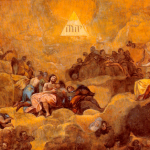
Heaven belongs in our catechisms, prayers, and creeds—but not in English Scripture translations.
Heaven help us, but the “heaven” we Christians talk about, pray to, and hope for, is simply not to be found in Scripture. Scandalous though it may be to say that, it is true, and it must be clarified for a great many confused people. That doesn’t make our belief in “heaven” wrong or bad. It just means that doctrine develops.
As we saw previously in a post on hell not being found in Scripture, ours is a time and culture most alien to that of our Mediterranean Biblical ancestors. The universe seen through our consensus reality is vastly different than that of Biblical peoples. When we look upwards, we see space and scientific astronomic phenomena radiating lightyears distant. But ages ago, they looked up and saw a fancy entourage of lesser divinities residing on a polished metallic or crystalline bowl-like surface enclosing everything on earth.
Inside our clubhouse called “Church” our group-nomenclature grows out of the earlier times. We are used to saying “heaven,” as in “Our Father who art in heaven…” (Matthew 6:9). And using the word “heaven” is fine for liturgy and catechesis! But that passage from “Matthew” wrongly translated to “heaven” is actually more honestly rendered as “sky vault.” Like this:
Our Patron, who is on the Sky Vault…
Late biblical scholar John Pilch gave us a treasure in his groundbreaking A Cultural Handbook to the Bible. He informs us that very time we read our English Bibles and see “heaven,” we can’t go wrong by scratching it out and writing “sky vault.” No matter if a passage is indicating the physical sky or the realm of God where a host of spirits dwell, “sky vault” is always the right rendering.
What about “heaven”? The “heaven” of our catechisms and contemporary theologies isn’t really so much a place, but rather an eternalized relationship between God and the saved. When contemporary theologians talk of “heaven” they mean a final human state of perfect happiness and enjoyment of God. The technical name for this is the “beatific vision.” “Heaven” then is a theological expression meaning the ultimate goal of human existence, our eternal destiny. “Heaven” is not so much a geographical or locational place, but an existential state.
About the Biblical Heaven Sky Vault…
When reading the document we call “Matthew” we encounter the phrase “Father in heaven.” This is the Matthean Jesus’ preferred way of referring to the God of Israel. It ought to be “Father/Patron in sky vault.” Consider:
NABRE Matthew 5:16
Just so, your light must shine before others, that they may see your good deeds and glorify your heavenly Father.
Corrected Matthew 5:16
Just so, your light must shine before others, that they may see your good deeds and glorify your sky vault Patron.
NABRE Matthew 5:45
…that you may be children of your heavenly Father, for he makes his sun rise on the bad and the good, and causes rain to fall on the just and the unjust.
Corrected Matthew 5:45
…that you may be children of your sky vault Patron, for he makes his sun rise on the bad and the good, and causes rain to fall on the just and the unjust.
NABRE Matthew 6:1
“[But] take care not to perform righteous deeds in order that people may see them; otherwise, you will have no recompense from your heavenly Father.
Corrected Matthew 6:1
“[But] take care not to perform righteous deeds in order that people may see them; otherwise, you will have no recompense from your sky vault Patron.
Consider also Matthew 6:9; 7:11; 7:21; 10:32-33; 12:50. Let’s keep “heaven” for Sunday school and prayers. But it’s always sky vault in the Bible, never “heaven.” Keep a marker handy, Bible readers!
Sky Vault, Not Heaven
But why the clumsy “sky vault”? Why not just sky? It is because Biblical authors didn’t see things, such as the sky, like we do. They didn’t know astronomy, meteorology, and the atmospheric sciences. So “sky” is too vague a translation. The “sky” they knew was a culturally-understood sky.
The Bible opens with these seven Hebrew words (read right-to-left)—
Genesis 1:1
בְּרֵאשִׁ֖ית בָּרָ֣א אֱלֹהִ֑ים אֵ֥ת הַשָּׁמַ֖יִם וְאֵ֥ת הָאָֽרֶץ
Translated, we get something like this: In the beginning created Gods the sky vaults and the earth. That word in red, hašāmayim, is plural and it reflects a cosmology of multiple metallic or crystalline vaulted-skies or domes. The creation myth of Genesis 1:1—2:4a, dating from sometime ca. 400 BCE, speaks of God creating the world. God hovers above a swampy chaos (tohu wubohu), and founds the world on an abyss of waters (tehom).
John Pilch explaines that this Greek plural form found in Matthew 6:9 (en tois ouranois) probably god influenced by the Hebrew plural šāmayim (or Aramaic plural šĕmayin). However, most often, the Greek form is in the singular, ouranos.
So from where did we get our spuriously familiar word “heaven”? Pilch, drawing from the Oxford English Dictionary, explains that the word “heaven” does not appear before eleventh-century translations of the Bible. We simply do not know its ulterior etymology.
Breaking Down Biblical Cosmology
In the Genesis creation story, the God of Israel (together with his entourage?), separates waters by way of a physical dome seen elsewhere in Biblical texts as made of polished metal mirror or glass or crystal. This “firmament” God calls “sky vaults” (Genesis 1:8, šāmayim) and these split the waters both above (Psalm 148:4) and underneath (Genesis 1:6-7). We are not speaking about the beatific vision, folks.
We are also are not talking scientific skies or space the final frontier. The Biblical sky vaults are every bit as solid as the land and mountains below them (Job 37:18), hard like metal or glass. Physical pillars keep the sky vaults up (Job 26:11). Like a master artisan of metalwork, God was able to stretch out these (molten?) domes as if they were a tent (Psalm 104:2; Isaiah 40:22).
Fiery Watchers, blazing nonhuman persons made of flame and wind, travel across the interior of the dome—these are stars, whether singular or contellated (Genesis 1:14-18; 15:5). God sits enthroned on sky vault with them (1 Kings 22:19).
How could this be referring to our scientifically-viewed skies or space? And how can this be referring to our theologically-evolved “Last Thing” called “heaven”?
Rainfall from Heaven Sky Vault
God carefully fashioned these sky vaults with a series of windows (Isaiah 24:18) that can open and shut. Through them, the Most High God can send blessings (Exodus 16:14; Psalm 78:24; Numbers 11:31; Job 26:13; Psalm 135:7; Jeremiah 10:13; Matthew 3:16; Acts 2:2; 1 Peter 1:12). But punishments also rain down through these windows (e.g., 2 Kings 1:9-15). Rain comes from the storehouse of waters above the dome (Genesis 7:11; Luke 4:25; Acts 14:17).
Heavenly Sky Vault Communication
John Pilch explained that the sky vault was a medium of communication from God to Israel (Genesis 9:12-17; Daniel 6:27). The voice of God is thunder; biblically, thunder signifies God speaking (Exodus 20:22; Jeremiah 25:30; Psalm 29:3; John 12:28-30). If one can discern interpret them correctly, various meteorological signs proclaim the intentions of the God of Israel (Luke 21:11, 25).
Journeys Into Heaven Sky Vault
According to John Pilch, the windows into sky vault allowed transit both to earth and the realm of God to various persons, both nonhuman and human beings. This crucially important detail is generally completely missed by Western commentators.
God originally willed an open sky vault for humankind. But Israelite tradition maintained that the opening was shut following the shameful behavior of the first human creatures. And yet whenever God desired the hole could be reopened (Revelation 4:1). Thus this explains the prayer of Third Isaiah (Isaiah 63:19).
At Jesus’ baptism the sky vault opened (Mark 1:10). As he was being murdered in Jerusalem, Stephen
looked up, and could see through the opening Jesus interceding before God (Acts 7:56). Peter experienced a vision of food descending through the sky hole (Acts 10:11).
Finding the Hole in Heaven Sky Vault
So many ancient Mediterrananean and Mesopotamian peoples believed that the sky hole was situated directly above their central temple. For many in the ancient Balkan Peninsula region it was over Delphi. For Chaldean peoples, it was over Babylon (Genesis 11:5). But for first century Israelites, the sky hole could be found directly over the Temple City, Jerusalem. This may help explain the many graves in the vicinity of Jerusalem—close to the sky hole from whence will come the Judgment.
This definitely explains why Jesus ascends from the area of Jerusalem. Why not Galilee? He had to go through the opening in sky vault. (No, the Ascension is not literal space travel or elevation, but those experiencing the vision of it would have understood it according to their culture’s cosmology).
Shamanic Sky Travelers
Israelite tradition records numerous shamanic persons who traveled through the sky hole. Enoch was the first (Genesis 5:21-23, the “books of Enoch” were composed sometime between third century BCE to the third century CE). Elijah (2 Kings 2:11) went up to sky vault. So did the astral prophets Daniel (Daniel 7–12), Ezekiel (Ezekiel 1:1), and John of Patmos (Revelation 4:1-2).
Sky journeys, visions, and trances are but a few of over 35 panhuman experiences cognitive neuroscience identifies as altered states of consciousness. Although rare for 21st century Westerner (unless sleeping or under controlled substances), all humans are capable of them. They are a level of human awareness that differs from pragmatic consciousness (or “waking” consciousness). God has “hardwired” us through the sacrament of evolution for these experiences and are God’s customary means of communication with us (1 Samuel 3:1-18).
Sky Vault: The Realm of God
As Israel’s tradition developed, its fascination with sky vault increased. We see this in the postexilic and intertestamental literature. What was going on up there where God and God’s fancy entourage was? Israel maintained that the sky vault was the throne of God (Isaiah 66:1; Matthew 5:34; 23:22; Acts 7:49).
For monarchic societies, the throne symbolizes royal authority and the monarch’s power. The throne
symbolizes absolute control over his subjects. In Hellenistic Egyptian sky lore, the constellation Virgo-Isis was the divine throne. Cassiopeia also was a well-known sky throne.
The Biblical sky vaults are henotheistic. God has a fancy entourage of sons and sky servants, the zaba šāmayim or “host of sky vault” (Genesis 2:1; Deuteronomy 4:19; 1 Kings 22:19; Luke 2:13). On his sky journey, John of Patmos witnesses twenty-four decans, nonhuman sky persons, seated on thrones around God’s sky throne (Revelation 4:4). These fiery lesser deities honor the Most High God (Revelation 4:10; 5:11; 5:14; 7:11; 11:16; 19:4). The sky servants know God’s cosmic plan. In altered states, they share it with prophets (Revelation 5:5; 7:13).
The great Ram or Male Lamb of God, the constellation we know to be Ares, leads the sky vault host and is the chief of the sons of God. This “Son of Man” or “Angel of the Lord” constellation is destined to eventually restore the original configuration of sky vault.
Multiple Heavens Sky Vaults
How many sky vaults did Biblical people believe exist? Israelites and other Mediterranean peoples speculated about the number. Different Biblical texts refer to “sky vault” and “the sly vault of sky vaults” or “the highest sky vault” (Deuteronomy 10:14; 1 Kings 8:27; Nehemiah 9:6; 3 Maccabees 2:15; etc.). The God of Israel was believed enthroned on the highest or most outer sky vault. Was this the third sky vault (2 Corinthians 12:2)? Other texts listed five, seven, and even ten sky vaults.
The Final Destination
According to various New Testament documents, the final destination for those loyal followers of Jesus is sky vault (2 Corinthians 5:1; Ephesians 2:6; Philippians 3:20; Revelation 11:12). But in these verses “sky vault” is a shorthand way of expressing being in God’s presence for eternity, rather than being physically on the sky vault as a place.
Sky vault therefor can be a metonym for God. This is especially true for the Matthean Jesus group. What comes from sky vault comes from God (Daniel 4:23; John 3:27). To be “with God” is to be “in sky vault”—whether you are physically in the place or not. This gives interesting directions for later theologians to contemplate the final destination and happiness of disciples as being a state rather than a place.
The Matthean Jesus gives the keys of sky vault to Peter, and instructs him that “whatever you bind on earth shall be bound in sky vault, and whatever you loose on earth shall be loosed in sky vault” (Matthew 16:18; and see also 18:18). For the Matthean Jesus group, “kingdom of sky vault” means what the other Synoptics call “the kingdom of God.” In other words, Israelite theocracy. So in theocracy God will affirm what Peter decides.
Changing Biblical Cosmologies
The library that is our Bible does not present one, consistent view of the cosmos. As Israelites experienced changes, so their view of the Universe changed. Generally speaking we can speak of two main views of Israelite cosmology found within the Scriptures. Documents written before 300 BCE usually see the universe as a flat earth surrounded by a saltwater abyss and enclosed within metallic or crystalline sky vault dome.
For literature after 300 BCE and under Hellenic influences, Israelites began to acknowledge the earth and seas as a stationary sphere. Two domes, the sky vault and “bottomless pit” meet at a celestial equator and encompass the stationary earth. This cosmological view is what John of Patmos has in mind.
https://youtu.be/3EspZtA7C3o
Conclusion
As we stated before in a post on the biblical roots of “hell,” the Cosmic World Tree idea is as old as Aboriginal culture, fifty thousand years at least. Not only do we find in this World Tree the ancient origins of “hell” but also the beginnings of the Christian heaven. Just as the roots of the Tree represent the underworld, so its branches signify the realm of the stars and gods.
And yet our Christian heaven—final happiness and beatific vision—are far more evolved and different from this ancient idea. There is relation, but great differences. The Biblical idea of sky vault/s is a middle step between our post-Biblical theology of heaven and the ancient shamanic Tree.
Again, there is no heaven in the Scriptures. It’s always sky vault/s. Heaven means eternal enjoyment of God and destiny of the righteous. Sky vault means literally the divine realm of God and spirits imagined by ancient Israelite sky lore to be on a physical dome.












